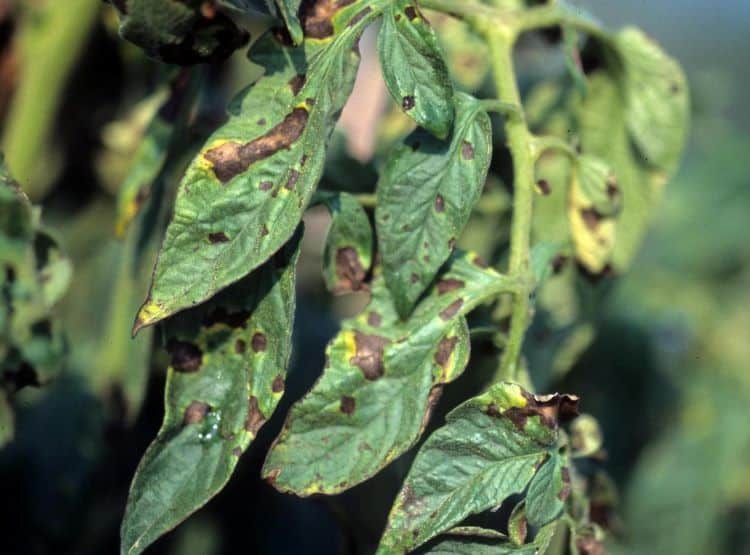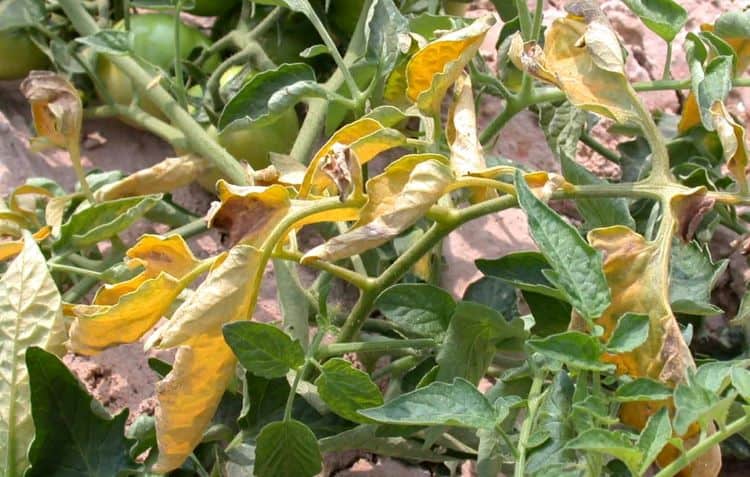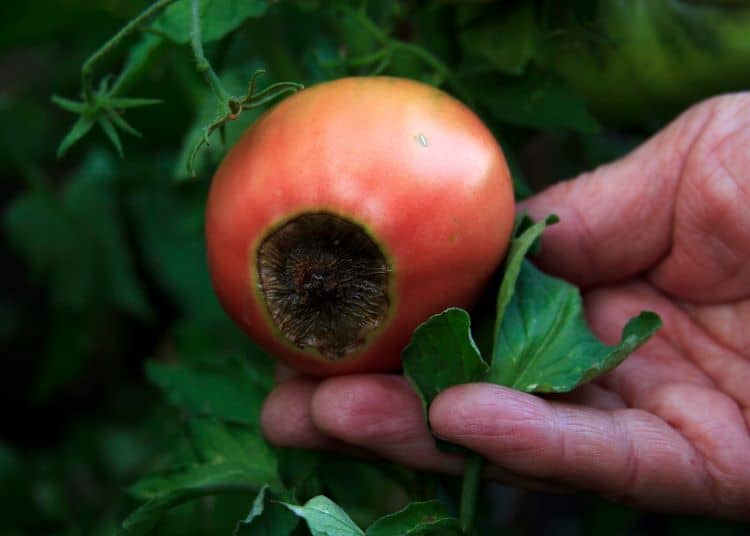
Prevent and treat tomato diseases to ensure your harvest of America’s favorite homegrown vegetable.
Tomatoes are the most popular edible plant grown in backyard gardens. Homegrown tomatoes more tasty than store-bought tomatoes. Plus, tomato plants are quite productive and easy to grow.
But you must prevent and treat tomato diseases to ensure a healthy harvest of homegrown tomatoes. That’s why the editors of Home, Garden and Homestead have put together this story about how to prevent and treat the five most common tomato diseases.
Follow the tips below to grow the best crop of tasty tomatoes ever! Also, check for Tomato Disease Control Products on Amazon. Home Garden and Homestead receives a small commission on sales generated by the links in our stories.
Prevent and Treat Tomato Diseases: Early Blight
Early blight is a fungal disease that can affect tomatoes, causing leaf spots, stem lesions, and fruit rot. It’s characterized by concentric rings on lower leaves, creating a ‘bull’s-eye’ pattern. Early blight is caused by the fungus Alternaria in relatively warm temperatures.
See below for how to prevent and treat early blight in tomatoes.

Prevention:
Follow these five tips to help prevent early blight from attacking your tomato plants.
- Crop Rotation: Rotate your crops each year to avoid the build-up of disease in the soil. Try not to plant tomatoes in the same place more than once every three years.
- Plant Resistant Varieties: Some varieties of tomatoes are bred to be resistant to early blight. These include Nectar, Juliet, and Matt’s Wild Cherry. Consider these when choosing your plants.
- Proper Spacing: Ensure plants are spaced well apart to increase air circulation, which helps the foliage dry faster, making it less hospitable to the fungus.
- Mulching: Mulch your plants to prevent fungal spores in the soil from splashing onto the lower leaves of the plant.
- Watering: Water at the base of the plant using drip irrigation or a soaker hose to keep foliage dry. If you must use overhead watering, do so early in the day to allow foliage to dry before nightfall.
Treatment:
- Prune Infected Leaves: If you spot signs of early blight, remove the affected leaves immediately to prevent the disease from spreading to the rest of the plant.
- Fungicides: Use a fungicide to control the spread of early blight. Fungicides containing copper or chlorothalonil are effective. Follow the instructions on the label for application rates and timing.
- Healthy Soil: Maintain healthy soil by adding compost and organic matter. Healthy soils foster strong plants that are better able to fend off diseases.
By following these steps, you can prevent early blight from establishing and manage it effectively if it does appear in your tomato garden.
Prevent and Treat Tomato Diseases: Late Blight
Prevent and Treat Tomato Diseases such as late blight to help ensure a healthy crop of homegrown tomatoes. Late blight (Phytophthora infestans) is a highly destructive disease that primarily affects tomatoes and potatoes. Unlike early blight, which is a soil-borne disease, late blight spores are airborne and thrive in cool, wet conditions. The disease can lead to significant losses as it spreads quickly and is often fatal to the plant.
Our guide to how to prevent and treat tomato diseases begins with Late Blight.

Prevention:
- Resistant Varieties: Some tomato varieties are bred to be more resistant to late blight. Legend, Red Grape, and Red Pearl varieties have all shown a resistance to late blight. These can be a good choice, especially in areas where late blight is common.
- Proper Spacing: Plant tomatoes with plenty of space between them to increase airflow and reduce humidity levels. This helps the foliage dry faster, making the environment less conducive to late blight.
- Watering: Water your plants at the base using a soaker hose or drip irrigation. This helps keep the foliage dry and less susceptible to the disease.
- Inspect Transplants: If you’re using transplants, inspect them carefully for any signs of late blight before planting them in your garden.

Treatment:
- Remove and Destroy Infected Plants: If you spot a plant with late blight, remove it as quickly as possible to prevent the disease from spreading. Do not compost infected plants as the spores can survive in the compost and infect future plants.
- Fungicides: Fungicides can be used to control late blight, especially copper-based ones or those containing chlorothalonil or mancozeb. They are most effective when used preventatively or at the first signs of the disease.
- Monitor Weather: Late blight spreads rapidly in cool, wet weather. During such periods, be extra vigilant about checking your plants for signs of the disease.
While late blight can be a challenging disease to manage, by being proactive and following these preventive measures and treatments, you can protect your tomato plants and ensure a healthy, productive crop.
Fusarium and Verticillium Wilt
Fusarium and Verticillium wilts are fungal diseases that infect the water-conducting vessels of a plant, causing wilting and often death of the plant. Both diseases are soil-borne and can persist in the soil for many years. Here’s how to prevent and treat tomato diseases such as Fusarium wilt and Verticillium wilt in your tomato plants. Prevent and treat tomato diseases such as Fusarium and Verticillium wilt to help ensure a healthy crop of homegrown tomatoes.

Prevention:
- Resistant Varieties: Many tomato varieties are bred to be resistant to one or both of these diseases. When purchasing seeds or plants, look for the letters “F” (Fusarium resistance) and “V” (Verticillium resistance) on the label.
- Crop Rotation: Rotate crops in your garden, especially if you’ve had problems with these diseases in the past. Try not to plant tomatoes (or other plants in the nightshade family, like potatoes, eggplant, and peppers) in the same place more than once every three to four years.
- Clean Tools: Clean your garden tools regularly, especially if you’ve been working with infected plants. This helps prevent the spread of the disease.
- Healthy Soil: Maintain healthy soil by adding organic matter and ensuring good drainage. This helps foster strong plants that are better able to fend off diseases.
Treatment:
- Remove Infected Plants: If you spot a plant that’s infected, remove it as soon as possible to prevent the disease from spreading. Do not compost infected plants, as the spores can survive and infect future plants.
- Solarize Soil: If the disease has been a consistent problem, you may want to consider soil solarization. This involves covering the soil with a clear plastic tarp during the hottest part of the summer to heat the soil and kill the fungus.
- Fungicides: While fungicides are often ineffective against these wilts once the plant is infected, they can be used as a preventive measure. However, using resistant varieties and practicing good crop rotation is typically more effective.
Remember the old phrase “an ounce of prevention is worth a pound of cure.” Persistent diseases such as Fusarium and Verticillium wilts are easier to prevent than they are to treat. Following these tips to minimize the risk of these diseases and ensure a healthy, productive tomato crop.
Tomato Mosaic Virus
To prevent and treat tomato diseases such as Tomato Mosaic Virus you must pay close attention to your tomato plants. Tomato Mosaic Virus is a disease that causes mottling and distortion of leaves, stunted growth, and reduced yield. The virus is highly stable and can be spread through seeds, soil, or tools that have come into contact with infected plants. Here’s how to prevent and treat Tomato Mosaic Virus:
Prevention:
- Use Virus-Free Seeds and Plants: Always purchase seeds and plants from a reliable source to ensure they are virus-free. Some seed companies sell seeds that have been steam-treated to kill the virus.
- Clean Tools and Hands: The virus can easily spread from plant to plant on hands and tools. Always clean your tools before moving from one plant to another, and consider wearing gloves when handling plants.
- Crop Rotation: Avoid planting tomatoes or other susceptible plants in the same area where an infected plant has previously grown.
- Resistant Varieties: Some tomato varieties have been bred for resistance to ToMV. Look for the label “T” for ToMV resistance when buying seeds or plants.

Treatment:
Unfortunately, once a plant is infected with Tomato Mosaic Virus, there’s no cure. The best course of action is to:
- Remove and Destroy Infected Plants: As soon as you identify a plant with ToMV, remove it from the garden to prevent the virus from spreading. Do not compost infected plants; instead, dispose of them in the trash.
- Clean the Area: Clean the area where the infected plant was growing, and sanitize any tools that came into contact with it.
- Maintain Vigilance: Keep a close eye on the remaining plants for any signs of the disease.
By being proactive and practicing good hygiene in your garden, you can minimize the risk of Tomato Mosaic Virus and ensure a healthy, productive tomato crop.
Prevent and Treat Tomato Diseases: Blossom End Rot
Blossom end rot in tomatoes is a common problem that many gardeners face. It’s a physiological disorder caused by a calcium imbalance in the plant, often triggered by fluctuations in soil moisture. Prevent and treat tomato diseases such as blossom end rot by taking the steps below.

1. Consistent Watering: Maintain a consistent watering schedule to avoid wet-dry cycles. Tomatoes typically require about 1-2 inches of water per week, but this can vary depending on the weather and the size of the plant. Providing consistent moisture helps the plant to absorb calcium from the soil more efficiently.
2. Mulching: Use mulch around the base of your tomato plants to help retain soil moisture and keep the temperature consistent.
3. Proper Fertilizing: Avoid using high-nitrogen fertilizers, as they can cause an overgrowth of leaves and lead to a reduction in the uptake of calcium. Additionally, the overuse of fertilizers can lead to salt buildup in the soil, which can interfere with the plant’s absorption of water and nutrients.
4. Soil pH: Test your soil pH to ensure it’s in the optimal range for nutrient uptake in tomatoes, which is around 6.2 to 6.8. Lime can be added to raise pH and provide calcium, while sulfur can be used to lower a too-high pH.
5. Planting Time: Planting tomatoes too early in cold soil can stunt root growth, limiting the plant’s ability to absorb water and nutrients.
6. Use of Calcium Additives: If your soil lacks calcium, use additives like lime, gypsum, or bone meal. Remember, even if there’s ample calcium in the soil, the plant can only take it up if soil moisture levels are consistent.
Final Thoughts: Prevent and Treat Tomato Diseases
By implementing these preventive measures, you can significantly decrease the chances of experiencing blossom end rot, late blight, and other diseases in your tomato plants.
Remember, your goal is to prevent and treat tomato diseases to keep your plants healthy. Healthy plants produce the most tomatoes!



Leave a Reply